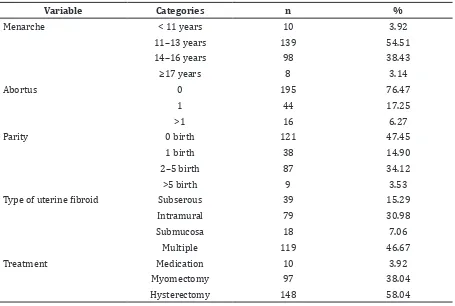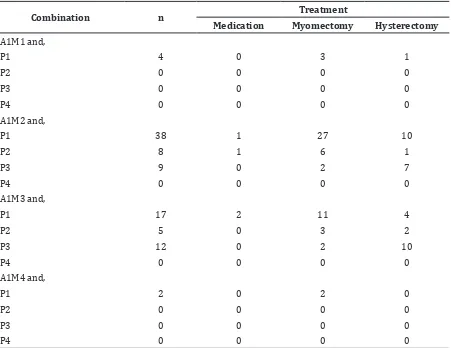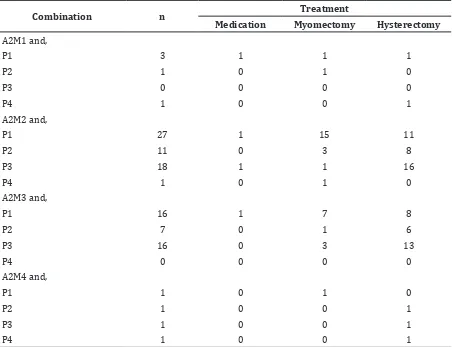Three Years Data of Uterine Fibroids Patient Characteristics at West
Java Top Referral Hospital
Mutiara Azzahra,1 Sharon Gondodiputro,2 Mulyanusa Amarullah3
1Faculty of Medicine Universitas Padjadjaran, 2Department of Public Health Faculty of Medicine Universitas Padjadjaran, 3Department of Obstetrics and Gynecology Faculty of Medicine Universitas
Padjadjaran/Dr. Hasan Sadikin General Hospital, Bandung
Abstract
Background: Uterine fibroids are the most common benign tumor in female reproductive system and a major cause in declining their quality of live. Patient characteristics has high prevalence in black women, 40s, nulliparous, and early menarche. These characteristics are varied in some areas and considered in treatment decisions. The objectives of this study was to describe the uterine fibroid patient characteristics at Dr. Hasan Sadikin General Hospital, Bandung from 1 January 2013 to 31 December 2015.
Methods: A descriptive study was conducted to 255 medical records of patients with uterine fibroids at Dr. Hasan Sadikin General Hosiptal, Bandung from 1 January 2013 to 31 December 2015. This study was conducted from September to November 2016. The variables were the year of treatment, age, education, occupation, married status, menarche, abortion, parity, type of uterine fibroids, and treatment. The collected data were analyzed and presented using frequency tables and percentages.
Results: Most cases of uterine fibroids were discovered in 2014. The most characteristics with uterine fibroids were pre-menopausal age (41.18%), high school education (55.69%), housewife (63.14%), normal menarche (54.51%), married (92.16%), nulliparous (47.45%), no abortion (76.47%), multiple uterine fibroids (46.67%), and hysterectomy (58.04%).
Conclusions: The most combination of characteristics of patients with uterine fibroids is nulliparrous women in reproductive and pre-menopausal age with normal menarche.
Keywords: Age, menarche, parity, uterine fibroids
Correspondence: Mutiara Azzahra, Faculty of Medicine, Universitas Padjadjaran, Jalan Raya Bandung-Sumedang
Km.21, Jatinangor, Sumedang, Indonesia, Email: mutiara2021@gmail.com
Introduction
Uterine fibroids are benign tumors from
smooth muscle of the uterus and most commonly occur in the female reproductive system, especially in the forties.1,2,3 In the United States3, 60% of 35 years old African-American women have uterine fibroids. In
Brazil4, uterine fibroids occur most commonly in the 35-44 years, and among white race l. In
Ghanaian women, this condition occurred <35 years old and the type was intramural uterine
fibroids.5 In Indonesia6, this condition ranks second of all gynecological cancer. A study in Medan7 in the period 2009–2011, uterine fibroids had high prevalence in the 40–49
years old, high school graduation, work as housewife, married, multiparous and the type
was submucosal fibroids.
There are several factors suspected to
be the cause of uterine fibroids such as
socio-demographic, hormones, genetics,
and lifestyle factors.8 Menarche, parity, age, obesity, smoking, diet, and exercise are several predictors contributing to the development of
uterine fibroids.9 These factors can be assessed
by identification of the patient characteristics
and can be a source of information to consider treatment options.1
Dr. Hasan Sadikin General Hospital Bandung which is the top referral hospital in West Java
has not yet published data on uterine fibroids
patient characteristics. Based on this, the study
was conducted to identify the uterine fibroids
patient characteristics at Dr. Hasan Sadikin General Hospital Bandung.
Methods
A descriptive quantitative study was conducted involving medical records of
Obstetrics and Gynecology, Dr. Hasan Sadikin General Hospital from 1 January 2013 to 31
December 2015 (3 years data). This study
was conducted from September to November 2016 and approved by the Health Research Ethics Committee of the Faculty of Medicine of Universitas Padjadjaran, No 631/UN6.C1.3.2/ KEPK/PN/2016 and Dr. Hasan Sadikin General Hospital Bandung, No. 4740 / UN6.C1 / PP / 2016.
The inclusion criteria for the medical records were medical records consisting of information about the year of treatment, age, education, occupation, menarche, married
status, parity, abortion, type of uterine fibroids,
and treatment. While exclusion criteria were incomplete medical records according to the variables needed. There were 383 medical records during 3 years, however only 255 medical records met the inclusion criteria.
In terms of age, age was divided into four groups according to the women’s uterine development, namely, the reproductive
age (15–40 years), pre-menopause (41–46 years), menopause (47–51 years) and post-menopause (≥52 years). The intervals of
menarche were divided based on the age of the
Table 1 Distribution Uterine Fibroids Patients characteristics in Dr. Hasan Sadikin General Hospital Bandung from 2013–2015
Variable Classification N %
Years of treatment 2013 68 26.67
2014 94 36.86
2015 93 36.47
Age 15–40 years 95 37.25
41–46 years 105 41.18
4–51 years 44 17.25
≥ 52 years 11 43.1
Education Elementary school 32 12.55
Junior high school 28 10.98
Senior high school 142 55.69
College 53 20.78
Married status Unmarried 20 7.84
Married 235 92.16
first menstruation, namely, early menarche (<11 years), normal menarche (11–13 years), menarche tarda (14–16 years) and late menarche (≥17 years). Moreover, parity was
divided into four groups based on the number
of delivery, namely nulliparous (null birth), primiparous (first birth), multiparous (2–5 births), and grandemultiparous (> 5 births).
The collected data were analyzed using a computer software and were presented by frequency tables and percentages.
Results
This study discovered that women aged 41–46
years had the highest percentage of uterine
fibroids, followed by women aged 15–40
years. Most of the patients were high school
graduates, housewives and married (Table 1).
In terms of menarche, girls in the age group
11–13 years had the highest percentage of
this disease, followed by girls in the age group
14–16 years. The highest percentage of the
case was in the never abortus, nulliparous and multiple group. There were some options to
that the most common treatment conducted
to this condition was hysterectomy (Table 2).
Based on the combination of variables age, menarche, and parity on the incidence
of uterine fibroid and treatment options
this study discovered that the most cases of
uterine fibroids in the reproductive age group had normal menarche (11–13 years) and nulliparous (Tables 3,4,5) .
In terms of the pre-menopause group, this
study discovered a similar result as in the reproductive group. Most cases of uterine
fibroids were patients who had normal menarche and nulliparous (Table 3).
Compared to other groups, the cases of
uterine fibroids in the menopause group had
a slightly different result. Most cases were still in patients who had normal menarche age but
had more than two children (Table 4).
In this study there were small low cases
of uterine fibroids in the post menopause age group. There were only 4.31% cases compared
to other groups. Hence, most cases had
menarche tarda and more than five children (Table 5).
Furthermore, treatment options based on the number of parity was hysterectomy, while
based on age was myomectomy. A combination characteristics on hysterectomy was the most
widely experienced by pre-menopause (41– 46 years), menarche tarda (14–16 years) and multiparrous (2–5 births), while myomectomy
was performed to women who were in the
reproductive age (15–40 years), normal menarche (11–13 years), and nulliparous.
Discussions
Uterine fibroid is a benign tumor that causes
the highest morbidity among women in reproductive age and fewer than in menopause. It consists of many smooth muscle cells and different types of connective tissue. Growth of the tumor presses to the multiple networks of myometrium and connective tissue, and
causes the formation of pseudo-capsule that consists of lots of collagen fibers and blood
vessels.10,11 Hormones, gen, and growth factors were factors suspected to contribute to the
development of uterine fibroids.12
This study discovered that most cases
of uterine fibroids occurred in the
pre-menopouse group. This result was in Table 2 Distribution of Uterine Fibroids Based on Obstetrics and Gynecology Status of
Patients in Dr. Hasan Sadikin General Hospital Bandung from 2013–2015.
Variable Categories n %
Menarche < 11 years 10 3.92
11–13 years 139 54.51
Parity 0 birth 121 47.45
1 birth 38 14.90
2–5 birth 87 34.12
>5 birth 9 3.53
Type of uterine fibroid Subserous 39 15.29
Table 3 Combination of Age, Menarche, Parity on Treatment Option of Uterine Fibroid Based on Reproduction Age
Combination n Treatment
Medication Myomectomy Hysterectomy
A1M1 and,
P1 4 0 3 1
P2 0 0 0 0
P3 0 0 0 0
P4 0 0 0 0
A1M2 and,
P1 38 1 27 10
P2 8 1 6 1
P3 9 0 2 7
P4 0 0 0 0
A1M3 and,
P1 17 2 11 4
P2 5 0 3 2
P3 12 0 2 10
P4 0 0 0 0
A1M4 and,
P1 2 0 2 0
P2 0 0 0 0
P3 0 0 0 0
P4 0 0 0 0
Note: A= Age: A1 (15-40 years), A2 (41-46 years), A3 (47-51 years) and A4 (≥52 years), M = Menarche: M1 (< 11 years), M2 (11-13 years), M3 (14-16 years) and M4 (≥17 years), P = Parity: P1 (0 birth), P2 (1 birth), P3 (2-5 birth), P4 (>5 birth)
accordance with a study by Ziemerman et al.3 that stated the age group 40-49 years has a high prevalence of uterine fibroids. Uterine Fibroids
occurring in menstruating women, showed the reliance on ovarian steroids, especially estrogen and progesterone that had a role in the development of this disease.10 Another study stated that at the premenopause age, increase urine concentration of estrogen and androgen compared to normal women, could be a predictor in the development of uterine
fibroids.13
Based on the education status, uterine
fibroids occur most commonly in women
who had already graduated from senior high school and college. The level of education was suspected to increase the stress level of a person.8 This was stated by Shen et al.8 that higher level of education was one of the other
factors on developing uterine fibroids, due
to stress level. Stress in a person who had a higher education was related to the changing endocrine system in women via steroid hormone, due to the disturbance of HPA axis responses to stress that result in changes of metabolism steroid hormone, and particularly
led to the development of uterine fibroids.8,14 In this study, normal menarche age had the highest frequency of all groups. This result is in accordance with the study of He et al.15 in China which stated that ≤14 years old
women have a higher percentage of uterine
fibroids compared to 15–16 and ≥17 years
old groups.15 It suspected that there are other factors contributing to uterine fibroids, such as
smoking, exercise and alcohol consumption. Those factors make women more susceptible
Additionally, nulliparous women had the
highest frequency of uterine fibroids. Uterine fibroids affect fertility due to inflammation
of the endometrium, inhibition transport of gamete embryo in the uterus, blood supply and anatomical disorders in the uterine cavity caused by development of the tumor. This condition has a devastating effect on fertility.16,17 Childbearing age women preparing for her first pregnancy, and have difficulty getting pregnant should be aware of
the possibility of obstetric complication risks
caused by uterine fibroids.16
Although cases of uterine fibroids in
the multiparous group were second rank compared to other groups, this study discovered that this situation existed. This
finding was in contradictory with the existing
theory. Multiparity reduced the risk of uterine
fibroid.13 After the delivery myometrium will
return to its normal state, such as weight,
blood flow, and the size of cells by apoptosis
and differentiation through the process of involution reduced blood supply to the myometrium.9 This explanation of uterine
fibroids in the multiparous group is still
unknown.
Furthermore, multiple uterine fibroids were the most type in this study. This finding was
not similar to a study conducted in Surakarta which stated that the highest number of uterine
fibroid is intramural, while the multiple is the
least of all.17 This result was also different with a study conducted by Sarkodie et al.5 in Ghana. There was no clear explanation about the
differences, whether there was spesific factors
in some areas related to the pathogenesis and
histologically findings.
Additionally, the most treatment performed was hysterectomy. This was consistent with a Table 4 Combination of Age, Menarche, Parity on Treatment Option of Uterine Fibroid Based
on Pre-menopause Age
Combination n Treatment
Medication Myomectomy Hysterectomy
A2M1 and,
P1 3 1 1 1
P2 1 0 1 0
P3 0 0 0 0
P4 1 0 0 1
A2M2 and,
P1 27 1 15 11
P2 11 0 3 8
P3 18 1 1 16
P4 1 0 1 0
A2M3 and,
P1 16 1 7 8
P2 7 0 1 6
P3 16 0 3 13
P4 0 0 0 0
A2M4 and,
P1 1 0 1 0
P2 1 0 0 1
P3 1 0 0 1
P4 1 0 0 1
previous study in Medan.7 Hysterectomy is the main therapeutic indication of uterine
fibroids in the United States.18 According to the management of the National Institute for Health
and Care Excellence (NICE), hysterectomy may
be performed if medication treatment failed and women did not want preserved their fertility.16 This study discovered an interesting result, that in some cases, hysterectomy was performed in women who had never delivered. The reason why this operation was perfomed was unclear.
In this case, the most combination
of characteristics uterine fibroids was
nulliparous. This disease most occurs in nulliparous women with normal reproductive age and normal menarche, followed by nulliparous women with premenopause and normal menarche. This condition becomes a particular concern to nulliparous women to
early detect their reproductive system related
to uterine fibroids.
Limitations of this study are the data collection from medical records, which are incomplete since not all patient characteristics
related to the risk factor for uterine fibroids
are recorded, such as anthropometry, family history, medical history, and lifestyles such as smoking, exercise, medicine.
The conclusion of this study, nulliparous in women is the most characteristics in uterine
fibroids, which occurred in reproductive and
premenopausal age with normal menarche and myomectomy as treatment.
References
1. Aleksandrovych V, Bereza T, Sajewicz M,
Walocha JA, Gil K. Uterine fibroid : common
features of widespread tumor. Folia Med Table 5 Combination of Age, Menarche, Parity on Treatment Option of Uterine Fibroid Based
on Menopause Age
Combination n Treatment
Medication Myomectomy Hysterectomy
A3M1 and,
P1 0 0 0 0
P2 1 1 0 0
P3 0 0 0 0
P4 0 0 0 0
A3M2 and,
P1 6 0 2 4
P2 2 0 0 2
P3 15 1 0 14
P4 1 0 0 1
A3M3 and,
P1 6 0 1 5
P2 2 0 1 1
P3 8 0 1 7
P4 1 0 1 0
A3M4 and,
P1 0 0 0 0
P2 0 0 0 0
P3 1 0 0 1
P4 1 0 0 1
Cracov. 2015;55(1):61–75.
2. Pérez-López FR, Ornat L, Ceausu I, Depypere H, Erel CT, Lambrinoudaki I, et al. EMAS position statement:
Management of uterine fibroids. Maturitas. 2014;79(1):106–16.
3. Zimmermann A, Bernuit D, Gerlinger C, Schaefers M, Geppert K. Prevalence, symptoms and management of uterine
fibroids: an international internet-based
survey of 21,746 women. BMC Womens
Health. 2012;12(6);1–11.
4. Boclin Kde L, Faerstein E. Prevalence of
self-reported medical diagnosis of uterine
leiomyomas in a Brazilian population: demographic and socioeconomic patterns
in the Pro-Saúde Study. Rev Bras Epidemiol. 2013;16(2):301–13.
5. Sarkodie BD, Botwe BO, Ofori EK. Uterine
fibroid characteristics and sonographic
pattern among Ghanaian females undergoing pelvic ultrasound scan: a study
at 3-major centres. BMC Womens Health. 2016;16(10) :1–6.
6. Baziad A. Endokrinologi ginekologi. 3rd ed. Jakarta: Media Aesculapius FKUI. 2008. 7. Ginting LY, Rasmaliah, Jamedi. Karakteristik penderita mioma uteri yang dirawat inap
di RSUD DR. Pringadi Medan tahun
2009-2011. Jurnal Gizi Kesehatan Reproduksi
dan Epidemiologi. 2012;1(1):1–9.
8. Shen Y, Xu Q, Xu J, Ren ML, Cai YL. Environmental exposure and risk of uterine leiomyoma: an epidemiologic survey. Eur Rev Med Pharmacol Sci.
2013;17(23):3249–56.
9. Parker WH. Etiology, symptomatology, and diagnosis of uterine myomas. Fertil Steril.
2007;87(4):725–36.
10. Khan AT, Shehmar M, Gupta JK. Uterine
fibroids : current perspectives. Int J Womens Health. 2014; 29(6):95–114.
11. Sparic R, Mirkovic L, Malvasi A, Tinelli A. Epidemiology of uterine myomas: a review.
Int J Fertil Steril. 2016;9(4): 424–35.
12. Ciavattini A, Di Giuseppe J, Stortoni P, Montik N, Giannubilo SR, Litta P, et al. Uterine Fibroids: pathogenesis and interactions with endometrium and endomyometrial junction. Obstetrics and Gynecology
International. 2013;2013(2013):173184.
13. Blake RE. Leiomyomata uteri: hormonal and molecular determinants of growth. J
Natl Med Socc. 2007;99(10):1170–84.
14. Wise LA, Li S, Palmer JR, Rosenberg L. Depressive symptoms and risk of uterine leiyomyomata. Am J Obstet Gynecol.
2015;212(5):617–35.
15. He Y, Zeng Q, Dong S, Qin L, Li G, Wang P.
Associations between uterine fibroids and
lifestyles including diet, physical activity
and stress: a case-control study in China. Asia Pac J Clin Nutr. 2013;22(1):109–17.
16. Cook H, Ezzati M, Segars JH, McCarthy K. The impact of uterine leiyomyomas on reproductive outcomes. Minerva Ginecol.
2010;62(3):225–36.
17. Trivedi P, Abreo M. Predisposing factors
for fibroids and outcome of laparoscopic
myomectomy in infertility. J Gynecol
Endosc Surg. 2009;1(1):47–56.
18. Vannuccini S, Clifton VL, Fraser IS, Taylor HS, Critchley H, Giudice LC, et al. Infertility and reproductive disorders: impact of
hormonal and inflammatory mechanisms
on pregnancy outcome. Hum Reprod
Update. 2016;22(1):104–15.
19. Kurniasari T. Karakteristik mioma uteri di RSUD Dr. Moewardi Surakarta periode
Januari 2009 - Januari 2010. Institutional
Repository Universitas Sebelas Maret. 2013 [cited 2017 January 6]. Available
form: https://eprints.uns.ac.id/4595/.
20. Baird DD, Harmon QE, Upson K, Moore
KR, Barker-Cummings C, Baker S, et al. A prospective, ultrasound-based study to evaluate risk factors for uterine fibroid
incidence and growth: methods and results of recruitment. J Womens Health




